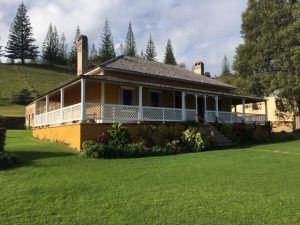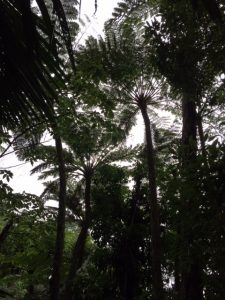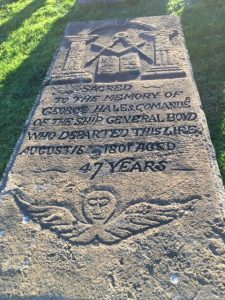National Trust (ACT) Norfolk Island Tour: August 2019
Norfolk Island has to be one of my most favourite islands in the sun. It has a temperate climate and an extraordinary mix of dark and light, both metaphorically and literally. There is deep time geology, magnificent flora, evidence of a fascinating Polynesian presence, the hideous cruelty of convict incarceration and, of course, the stunning Georgian buildings that remain as testament to those dark times. Arriving in 1856, the Pitcairn Islanders, descendants of the HMS Bounty mutineers, saw the ultimate shaping of the Island’s culture which leavens the dark past with resilience, conviviality and warm hospitality.
With the good luck to have Eric Martin AM as our tour leader, we had six delightful days exploring the multifaceted, multi layered Norfolk Island. There’s only space to provide a few of the highlights. Eric’s report on the island’s architectural heritage1 gives an excellent and concise overview of the settlements, lists the various management plans and current challenges.

The World Heritage listed Kingston and Arthur’s Vale Historic Area (KAVHA), as stated by the Australian Government, is noted for its ‘picturesque character, outstanding Georgian buildings and evocative ruins’2. The various heritage listings are provided below3,4.
We walked among the ruins of the New Gaol and could hardly imagine the privations of inmates. Norfolk Island was to be a place of secondary punishment for, in Governor Darling’s view, those convicts deserving ‘that Settlement as a place of extremist punishment, short of death’5. While viewed favourably by some of their contemporaries, the passage of time has reassessed the reputations of commandants such as Foveaux, Anderson, Morisset (ibid) and Price6. The latter’s cruelty even depicted in Australian literature7.
So much of the KAVHA precinct comprises excellent design and draftsmanship, sound planning and implementation by the Royal Engineers with the heft of the actual construction undertaken by convict labour. It is easy to wax eloquent about a very particular section of KAVHA, Quality Row. Built as officers’ quarters between 1832 and 1847, Quality Row now forms one of the most outstanding Georgian precincts. It was the Royal Engineer, Lieutenant Lugard, we must thank for most of these Georgian houses – buildings that stand exquisitely in their simplicity and proportions8,9.
To experience the interiors of these restored houses and actually spend time dining and taking morning tea was a delight. The three-course dinner served at Number 9 Quality Row introduced us to some of the dishes from the Pitcairn Islander culinary fare. Very useful too, was to see coloured layers on walls stripped back to their original state showing evidence of many decades of habitation. It was a treat indeed not only to explore the formal and informal rooms of Government House but to join the current Administrator, Eric Hutchinson, as he hosted us at morning tea. The complexity of restoring and maintaining working heritage-listed buildings was made very apparent during this visit. Appropriate choice of colour is but one consideration. Replicating the type of paint used and calculating the right formula definitely has to be alchemy at work. The Purcell Condition & Conservation Report, July 201710 provides further information on these maintenance and conservation issues.

Everywhere are the iconic Norfolk Island Pines – Araucaria heterophilla is a conifer but actually not a pine tree – shaping views to the horizon in virtually every direction. When Cook arrived on Norfolk Island in 1774 he noted the abundance of these magnificent trees, some reaching 60 metres, and presumed they would be ideal for use as masts for the Royal Navy. Their mechanical properties were not suitable for this purpose. There were also great hopes for an industry based on the flax plant, Phormium tenax, but these were also never realised11.
The tree ferns on Norfolk (Cyathea brownii, Cyathea australis sub. Sp. norfolkensis) are the tallest tree ferns in the world12. It’s a real neck tilt to focus a lens on their fronds way up against the sky and often as high as 16 metres.
We heard about the amazing recovery from near extinction of the endemic green parrot but sadly only caught glimpses of the introduced Australian crimson rosella between the trees. Yes, our rosellas are unfortunately a feral species in this Island environment. From the cliffs at the edge of the National Park we witnessed a beautiful sight. Large masked boobies were gliding, with barely the flick of a wing feather, gracefully, despite their name, riding the thermals. There were brief sightings of the gorgeous Norfolk Island kingfisher frustratingly out of reach for a good camera shot.
We all relished the conviviality of the Pitcairners themselves. The progressive dinners were terrific. We heard stories of the whaling days, the perils of encountering wandering cattle (they have right of way), living on Pitcairn Island itself and hearing nursery rhymes recited in Norf’k, the language that emerged from the Polynesian and English speakers on Pitcairn Island.

It is evident that the build form provides a testament to history but so do place names and the surviving Norf’k language. As the 2016 Australian National Placenames Survey13 notes, place names survive today, like “Bloody Bridge,” from the convict settlement and also from the relocation of the Pitcairn Islanders. Names appeared such as “Stone fer George and Isaac’s” (George and Isaac’s Stone), “Ar Pool fer Helen’s” (Helen’s Pool), and “Dar Coop” (The [Chicken] Coop). Even more intriguing was hearing the hymns sung at All Saints, Kingston that were written and the music composed, by descendants of the Bounty mutineers14. These words and music seem to form an eloquent time capsule.
Norfolk Island faces many significant challenges including climate change, black rats, feral chooks, invasive guava trees, governance changes15 and contractors with a lack of conservation experience.
From the feedback we have received it appears many of us could have stayed longer, delving more deeply into the history and heritage, deciphering tombstones, taking in more detail of the design vocabulary of the Georgian architecture, enjoying the warm hospitality of the Islanders – that freshly caught and smoked Trumpeter was truly delectable – wandering back through the National Park and museums, and brunching in the village on smashed local avocados with excellent coffee.
We look forward to more reminiscing at further tour reunions!
Marianne Albury-Colless
Councillor, National Trust (ACT)
References
- Martin, E. 2017, ‘Conservation of Norfolk Island’s Architectural Heritage’ www.emaa.com.au/uploads/4/6/3/2/46326229/2017_ni_conservation.pdf
- ‘Kingston and Arthur’s Vale Historic Area Norfolk Island’ www.kavha.gov.au
- Australian Government, ‘Australia’s World Heritage List’ www.environment.gov.au/heritage/places/world-heritage-list
- Australian Government, Norfolk Island Administration, Jean Rice Architect, Context Pty Ltd & GML Heritage Pty Ltd, 2016, ‘Kingston and Arthur’s Vale Historic Area Heritage Management Plan’ (originally published in the Commonwealth of Australia Gazette No. 8141, Aug 2007). For criteria and values justifying KAVHA’s listing on the National Heritage List, Commonwealth Heritage List and Norfolk Island Register, see Heritage Management Plan 2016 pp. 171–183 & pp. 201–205 www.regional.gov.au/territories/norfolk_island/files/KAVHA-Heritage-Management-Plan.pdf
- State Records Authority of New South Wales, ‘Norfolk Island Penal Establishment’ https://researchdata.ands.org.au/norfolk-island-penal-establishment/165732
- Barry, J. (1967) ‘John Giles (1808–1857)’ Australian Dictionary of Biography http://adb.anu.edu.au/biography/price-john-giles-2563
- ‘Price Warung’ (William Astley) ‘John Price’s Bar of Steel’, Drake-Brockman, H. (Henrietta), 1901-1968 & Murdoch, Walter, Sir, 1874-1970 1997, Classic Australian short stories, Oxford University Press, Melbourne
- GML Heritage, Context, 2018, ‘Kingston and Arthur’s Vale Historic Area Cultural Landscape Management Plan (Draft) Report’, prepared for Department of Infrastructure, Regional Development and Cities www.kavha.gov.au/sites/default/files/documents/draft_kavha_cultural_landscape_management_plan_2018.pdf
- Australian Government, 2016, ‘Kingston and Arthur’s Vale Historic Area Heritage Management Plan’ Federal Register of Legislation, www.legislation.gov.au/Details/F2016L01891/Html/Volume_6
- Purcell Asia Pacific Limited, 2017 ‘Kingston & Arthur’s Vale Historic Area Norfolk Island Condition & Conservation report’ www.kavha.gov.au/sites/default/files/documents/kavha_condition_and_conservation_report_2017.pdf
- Coyne, P. 2011, Norfolk Island’s Fascinating Flora, Petaurus Press, Belconnen ACT
- Australian Government, ‘Flora’: www.environment.gov.au/topics/national-parks/norfolk-island-national-park/natural-environment/flora
- Nash, J. 2016, Norfolk Island ANPS (Australian National Placenames Survey) Data Report No. 1, Placenames Australia (Inc.) South Turramurra, NSW www.anps.org.au/upload/ANPSDataReport1.pdf
- The Church of England Hymn Book: Norfolk Island, Pitcairn Island and Traditional Hymns, undated.
- Australian Government, ‘Norfolk Island Governance’ www.regional.gov.au/territories/norfolk_island/governance/index.aspx
